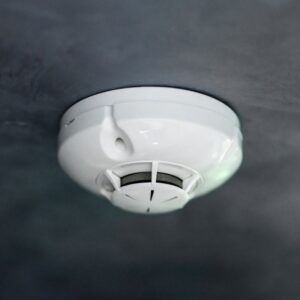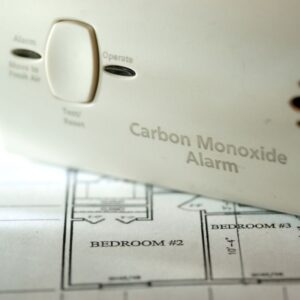A deadly toxic gas that can enter your home if you have venting problems with your chimney or other heating unit, carbon monoxide is responsible for killing over 400 Americans by unintentional poisoning annually.
According to the Centers for Disease Control and Prevention (CDC), carbon monoxide poisoning also sends over 20,000 people to the emergency room, and more than 4,000 people end up having to be hospitalized due to carbon monoxide poisoning. This is why it’s very important to have your chimney inspected annually to ensure your chimney system is venting properly.
Our Chimney Safety Institute of America-certified technicians, who are experienced with solving carbon monoxide issues, would like to tell you more about this toxic gas that can silently enter your home and cause serious health damage…
What Is Carbon Monoxide Gas?
 Carbon monoxide is a colorless, odorless, tasteless, and extremely toxic gas that is produced by burning fuels. Carbon monoxide is often called the “silent killer” because due to its properties, it is impossible to detect without specific equipment.
Carbon monoxide is a colorless, odorless, tasteless, and extremely toxic gas that is produced by burning fuels. Carbon monoxide is often called the “silent killer” because due to its properties, it is impossible to detect without specific equipment.
Carbon monoxide is produced by the incomplete combustion of fuels, including the wood, natural gas, or propane you use to heat your home. Depending on the type of heating appliance you have, your appliance may either burn hot enough to combust all traceable levels of carbon monoxide, or it will be vented out of your home through a chimney or ventilation system. If a ventilation system becomes blocked, such as from soot, debris, or nesting animals, carbon monoxide can be forced back into your home rather than exiting through the chimney or ductwork. A malfunctioning appliance also can cause a carbon monoxide hazard.
Its many sources include burning coal, wood, charcoal, oil, natural gas, kerosene, and propane. This means that most fireplaces, stoves, grills, space heaters, water heaters, furnaces, and even vehicles produce carbon monoxide gas. However, these appliances are normally either properly vented or located outdoors so they pose little to no risk to homeowners and their families.
What Are the Symptoms of Carbon Monoxide Poisoning?
Headache, dizziness, nausea, vomiting, weakness, chest pain, and confusion are all symptoms of low-level carbon monoxide poisoning. Since these symptoms are so similar to the flu or the common cold, carbon monoxide poisoning can be difficult to diagnose.
If you believe that you are experiencing the symptoms of carbon monoxide poisoning, immediately move to a fresh air location. Ideally this is outside, but can also be next to an open door or window. Call Poison Control and local emergency services before reentering the building.
If you persist in having these symptoms, ask your doctor for a carbon monoxide level blood test. High-level symptoms include organ damage, loss of consciousness, and death.
How Does Carbon Monoxide Poisoning Happen?
For some reason, your red blood cells would rather pick up carbon monoxide than oxygen. If there is a lot of carbon monoxide in the air, your body may replace all of the oxygen in your blood with carbon monoxide, blocking oxygen from entering your body, causing tissue damage and resulting, possibly, in death. Tissues can also be destroyed by carbon monoxide teaming up with the proteins in tissues.
How Do I Prevent Carbon Monoxide Leaks From My Chimney?
 Have your fireplace and chimney cleaned and inspected by a reputable chimney company like Lords Chimney every year.
Have your fireplace and chimney cleaned and inspected by a reputable chimney company like Lords Chimney every year.- Generators and grills should never be used indoors or in enclosed spaces such as garages or sheds.
- If you are purchasing a gas fireplace, be sure it carries the seal of a national testing group, such as the CSA Group.
- If your heat ever goes out, never use a portable flameless chemical heater indoors, and do not use your stove or oven to heat the home, either. Although they do not have a flame, they do burn gas and can cause carbon monoxide to build up inside your house.
- Do not allow cars to idle in garages, even when the garage door is open.
- Move grills away from windows and doors.
- Most importantly, install a battery-operated carbon monoxide detector in your home, and check and/or replace the batteries when you reset your clocks in the spring and fall.
How Do I Vent My Gas Appliances Properly?
Firstly, never burn anything in a fireplace that is not vented. Secondly, never patch a vent pipe with tape, gum, or anything else, which could cause carbon monoxide to build up more quickly. Thirdly, your indoor vent pipes should go up slightly as they go towards the outside. This helps prevent toxic gases from leaking if the joints or pipes are not fitted properly.
Questions? Give Us a Call
If you have any more questions about carbon monoxide, contact us today. Our experienced staff can answer whatever else you need to know about the dangers of carbon monoxide poisoning.

